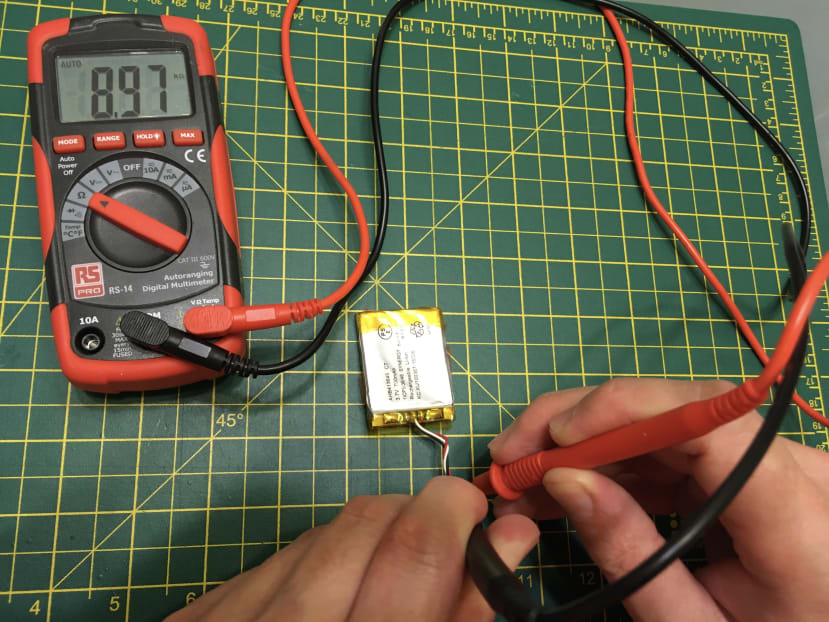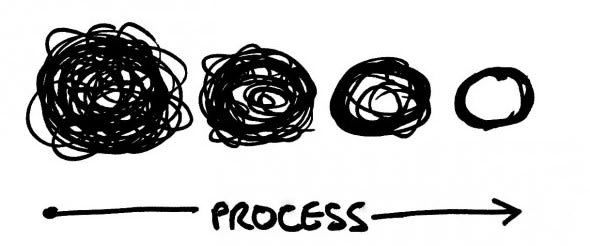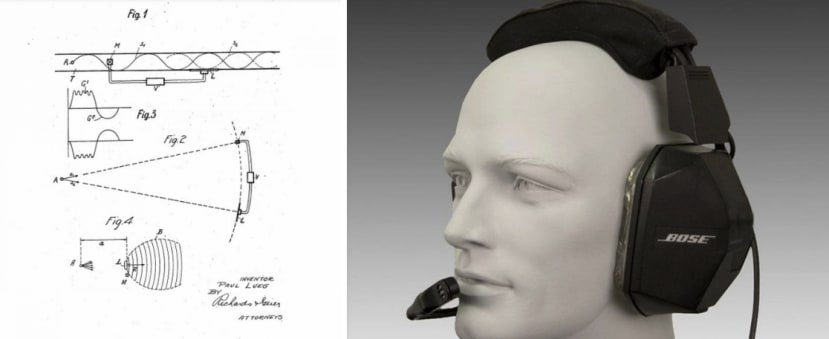The Fight to Repair - Part 3: Falling in Love With The Problem of R2R, Looria, and Pre-Purchase Reparability Considerations.
Follow articleHow do you feel about this article? Help us to provide better content for you.
Thank you! Your feedback has been received.
There was a problem submitting your feedback, please try again later.
What do you think of this article?
If you've made it this far, you can appreciate I was not just obsessed with fixing my headphones - but trying to understand why they broke in the first place? Why are things not built to last as long or to be repaired? What comes next in Design?
As part of a series of articles, this one will focus on:
- After some follow-up work on Thermistors within LiPos, I realised he was seriously ‘down the Rabbit Hole’ now, and had to keep going to understand more. Let the FOFA begin!
- What if Reviews were honest about products as they age and break? Enter: Looria.com
Is this a ‘signal’ of an emergent consumer behaviour to consider ‘repairability’ before buying?
This could be really groundbreaking.
Why Don’t You [My Headphones] Like My 3rd Party Batteries?
Subsequent to the very insightful conversation with Dr Laurence’s sober evaluation of ‘chipping’ or ‘reverse specifying’ a battery to *only* work with a given product, I nonetheless was still ‘back to square one’, so I relayed my findinging and problematic charging behaviour I was experiencing back to Don and Andy, [ex-Dyson embedded electronics gurus]. Aside from being pedantic about ‘getting to the bottom of this’, I genuinely saw this as a way to learn a good deal about how LiPo batteries worked, and what things are incompatible between one device and another power source.
Thermistors in the Batteries.
The first thing Andy suggested I do was to check the Thermistor Value, of both the original and the new 3rd party batteries. He said most will either be around 10kOhm, or 120kOhm resistance(s). It was unlikely in his opinion that this is the ‘checking method’ for preventing third party batteries working, but it might be interesting to investigate nonetheless...
Most LiPo batteries only need two wires - a Red and Black - for power. However, if you see a third wire (usually white/yellow) this relates to temperature sensing. As mentioned in the AdaFruit blog, LiPos are inherently a bit dangerous if allowed to go out of their normal operating parameters - one of those being temperature. So some have a built-in temperature sensor (thermistor) in them, and will shut down the battery charging/discharging if the internal temperature is above say 45C. Batteries do not like being above 50C as a general rule.
Thanks to my handy MultiMeter, I was able to easily check the Thermistor Value for the original, which of course varies with temperature a little (Hong Kong, where I was temporarily based, being hot, this lowered the resistance from perhaps 10kOhm to 9kOhm), and the other 3rd Party batteries were around this value, give-or-take 1kOhm which was in the reasonable range, and seemed unlikely to be the cause, as Andy had suspected.
Darn it.
It’d now been about 4 weeks on-and-off of trying to get to the bottom of this.
To date: Nothing.
(Meanwhile, other family members are losing their patience with the wok disappearing from the kitchen.)
The Case for ‘Finding Out’ & ‘Faffing Around’ ;o)
Above: Roger Skaer, explaining a classic creative / technical tension.
As described by Roger Skaer, immortalised in a viral internet meme, he is discussing the notion that the amount of time you need to ‘Find Out’ seems to correlate proportionally to how much time you have to ‘F**k Around’. If you don’t like infographics with cuss words, please avoid this video.
I think many engineers will relate to the experience of sometimes taking a different approach when at a dead-end, or verifying something you think you know all about, or when you don't expect anything noteworthy to come from - and then in doing so, you unexpectedly hit upon something really useful. You gain the extra insight you didn’t know you needed!
Architect Thomas Heatherwick dubbs this approach ‘purposeful aimlessness’, and renowned marketeer John Heagerty describes similar ways of priming the mind to connect the dots, yet in engineering we often are anxious about the ‘looseness’ of such a method and are reluctant to call something so non-linear a ‘Process’, and yet ask around many of the best creatives, and they may be honest that the Eureka moment was in fact months or years in the making.
Above: Artist, and friend, Brendan Dawes illustrates it this way. Nailed it.
For me, this was one of those very moments - wondering why some batteries had 2 wires and some had 3 wires? Pondering why LiPo batteries were not standardised like Alkaline Batteries? Confused by why were some products easy to disassemble and some not? These questions and more were building up to something it seemed... The ‘simple/stupid’ questions often are the best.
A Closer Look at Sony & Bose ANC Headphone Battery Replacements.
Searching YouTube for other Battery Replacements for Noise Cancelling Headphones, I found a video tutorial for the Sony WH1000XM4’s, which are arguably a good ‘update’ to my Sennheiser headphones, in terms of specification, and of course 6 years later, are even a bit cheaper.
Anyway, I took a closer look at the battery, which is very similar to the Sennheiser configuration, only that it had 2 wires. Having used Sony products for some years, I didn’t think they’d ‘cut corners’ and omitted a crucial safety feature in LiPo battery integration, so paid closer attention and found that they had just ‘done one better’, and added their own Thermistor on a ribbon flex PCB that can be seen on the left (as a thin yellow stripe).
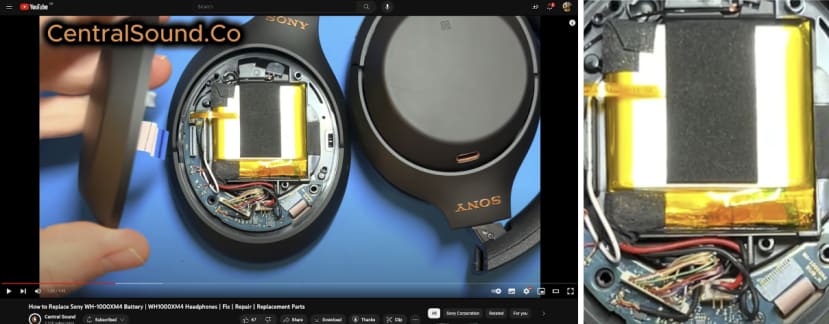
YouTube being a great recommendation engine, I was presented with a ‘watch next’ of the Bose QC45.
Interlude: Our Complex Relationship to Tech and Provenance: The Truth is Often Complex.
You may know that Bose is the ‘OG’ of the first publicly available ANC headphones, but I’d also highly recommend you check out the deeper history from the fascinating Headphonesty blog which explains that all too familiar story of wartime driving innovation, and how the consumer evolution of this is always a little more complex than just a ‘cost down’.
Above: Drawings by Paul Lueg that illustrates the process of silencing sound oscillations. (From: https://patentimages.storage.googleapis.com/). The Bose Aviation Headset (From: aopa.org)
Having worked in Tech for some years now, I note that I often surprise people when I matter-of-factly point out that many aspects of consumer tech come from Defence/Military innovation. A common example is that the accelerometers in your phone/smartwatch/gaming devices originated as a missile guidance system, and only a few decades ago cost thousands of pounds and now the technology is ubiquitous, found in pretty much anything you’d call ‘smart’ that moves. My point being that when people ask about ‘disruptive tech’, often it is disruptive when it moves from one industry to another unexpectedly.
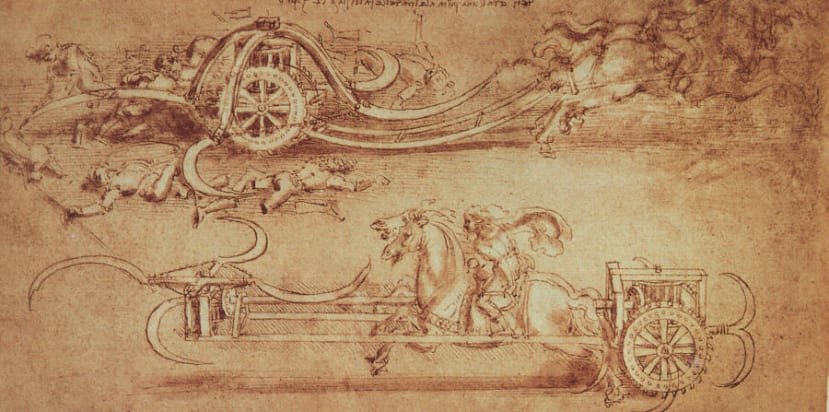
It is much rarer for consumer tech to ‘come from nowhere’, and it’s nothing new, as even Da Vinci when not working on art, was busily designing war machines for the ruling classes to conquer new lands, and defend their existing ones. All of which is to say, our relationship with technology is a somewhat ‘selective hearing/seeing/knowing’ relationship, and perhaps is why Sustainability, with it’s thorny issues like child labour and conflict minerals like Cobolt for Cellphones/Batteries is not always paletable or easy to boil down to good and bad. Arguably, the truth will set us free to make better decisions for the planet and people, such as the Fair Cobalt Alliance (as found via Fairphone’s pledge).
Getting back to the Right to Repair agenda, this is where the ‘reading around’ the subject really hit upon an interesting comparison...
Bose vs Sony - Neck-and-Neck on Spec, Price, Reviews...but what about R2R?
These two ‘big sellers’ in the ANC headphone world are a fascinating contrast. And as to my earlier FAFO point - I only found out about them because I was looking around at the difference between 2 and 3 wire LiPo batteries. However, I realised something more interesting than the thermistor wires - a staggering difference between the two products that at the time of their release is not something many reviewers picked up on...
I seemed to have stumbled upon my first WTF Moment in R2R...
Above: CentralSound teardown of Sony and Bose headphones - in short, Bose if very complex, Sony is pretty easy. So when comparing on Amazon, the reviews and technical specs are near identical, posing the question - "is repairability the differentiating factor between these otherwise near-identical products'?
Sony WH-1000XM4 (left video), released 2020, and Bose QC45 (right video), released 2021, are basically identical in terms of Price, Spec, and general Reviews by users. It is almost uncanny how close they are, and shows how fast a company like Sony can play ‘catch up’ to Bose, if the market incentives are there, and a point to say how fast innovation can be driven when profits are commensurate with the effort to get there!
At this point the 2 vs 3 wire battery issue was completely overshadowed by the fact Sony was an absolute breeze to replace the battery (for someone on DesignSpark that is!), and to be fair, so was my Sennheiser MB 660 (released 2016). However, replacing the battery on the Bose QC45 (2021) was an absolute nightmare - despite being a pretty experienced engineer, I seriously believe I might do irreparable damage to the Bose QC45’s - even with the video guide. And in case you’re wondering, the Bose QC35 (2016) is no easier to replace the battery.
Bose QC45 Battery Repair (from CentralSound.co)


In contrast, the Sony repair has arguably as many steps, but it is night and day - and the commentary says it all: Every other phrase is ‘pretty simple’, or ‘comes away/out easily’.
Sony WH-1000XM4 Battery Repair (from CentralSound.co)

Will Reviews with a R2R rating ever happen?
A Compelling Alternative: “Exit Reviews” (Looria.com)
I posted my issue with my battery/headphones on Reddit, and later found a subreddit around someone who was championing “Exit Reviews” - in other words, most Reviews on Amazon are from people who have just unboxed a product, so of course it’ll likely be fine, and/or you have not found the real gremlins just yet (and probably won’t bother going back to update the review - as it stands delayed/exit reviews are not incentivised formally or informally.).
Instead, this is a ‘fail-log’ for prospective buyers, but also I hope, for Engineers and Designers to see ‘what went wrong in real life’ with the products they designed (or to get tips for their coming designs!).

Not only did they have my Sennheiser MB660 headphones, which sure enough my problem is not unique, but also many other popular brands including the Sony and Bose ANC headphones. This website still looks very new / ‘early days’, and of course it’s a certain type of person who does these reviews... it’s a niche thing, to be sure.
That said, i have to be fair and say that for the particular Bose QC45 model, there are no complaints, although this is more likely a lack of input as the Bose QC35 (and others) which has essentially the same design do have cited failures, which can likely be assumed for the later model in all probability.

It seems too early to tell if this means Bose QC45 has no major issues, or is ‘more durable’ than Sony’s equivalent the WH-1000XM4, but I don’t think it detracts from the fact that if you have to replace a battery in either, I’d still choose the Sony, (between these two) even if it seems they have some real issues with not straining the headband too much or it breaks.
When searching Looria for the Sennheiser headphones, I found this particular post interesting - as it not only cited a problem, but also linked out to a fix to attempt to fix it. I can’t help feeling Looria and iFixit need to team up, as they compliment each other nicely, wouldn’t you agree?
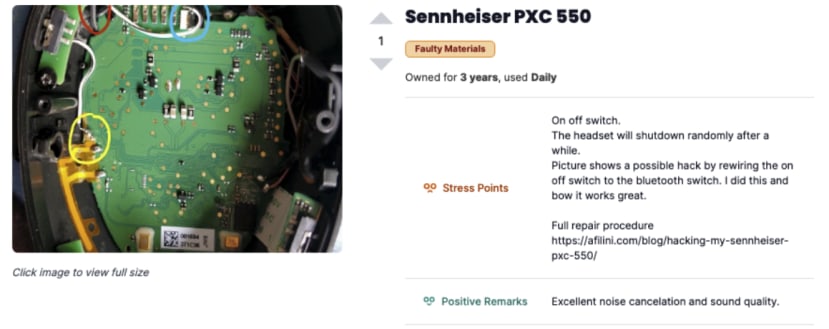
I wonder if a natural extension for Looria is not just to cite the failures, but also encourage people to propose fixes like the one above. As arguably if a ‘common fault’ was compensated by an ‘easy fix’, this is arguably better than a ‘rare, but catastrophic failure’. The two arguably need their scores to be ‘multiplied’ together to get the resultant ‘likely longevity’ of a product, perhaps?
A Free Post-Mortem for Designers. We are all wise after the fact!
And so we come full circle to the need to make it easy for products to be repaired.. This for me underscores the essence of Right to Repair, and is about learning from one generation to another. Having been an engineer ‘responsible’ for both first and subsequent / next generation models (at Dyson, as co-lead on AM10 Humidifier, a first-of-its-kinds for the company) , I am all too aware the first gen will always have (hopefully minor) oversights. But the attitude is to have good after sales care - which includes spares and repairs.
A final note on this is that I love the ‘Exit Review’, not because it cites an ‘unlucky break’, but rather it helps you ‘read between the lines’. If you read that things break if you drop them, but you’re not a very clumsy person, you may still go ahead with a purchase. Conversely, if you read that a peculiar electrical fault can occur randomly after 1-2 years, or that the battery is going to fail between 3-4 years, this may make you evaluate it very differently, as it’s something you can’t just ‘be more careful’ about.
As a designers, one of course does not want to see their work in a ‘hall of infamy’ like this, but at the same time, it has three positive triggers which may be good for a designer to consider:
- You can create an anonymous account and potentially post a really great fix. Perhaps that cable that always works loose can be fixed in 5mins, and you create a great photo guide. People may well appreciate that - but only if you haven’t used a load of glue and snap-fits in your design in the first place! So again, this prompts the Right to Repair mindset, where permissible.
- If you are working 100% in the vanguard, you’ll have to take the first generation on the chin as having issues, and indeed, Phil Knight explains why this isn’t as terrible as you think in his Nike memoir Shoe Dog - the key is how you respond to it to make it right. Again, it’s about mindset.
- So let’s say you are making a ‘known product’, albeit with a twist or new take. Now the ability to search a powerful database of the ‘greatest fails’ and ‘biggest bugbears’ of what people hate in this category of product is invaluable! If you can have the humility to consider that you too may screw-up, reading up on common failure modes (buttons and joints on headphones seems like two good places to start!), you could make a really loved product that just gets those bits right ‘first time’, or like Fairphone’s Fairbuds XL, it anticipates a necessary upgrade because of wear and tear, misuse, or an accidental breakage.
Contents:
Prologue:
Pre-Departure Notice - How an Attempt to Repair my Headphones Turned into a 3-Month Journey with a Grand Finale at the Recycling Centre.
Main Articles:
Intro - The Fight to Repair with Jude Pullen, for RS DesignSpark.
Part 1 - LiPo Battery Basics, Headless Laptops & Safety First.
Part 2 - Returning to Hong Kong, My Design Conspiracy Theories and Meeting Dr Lawrence.
Part 3 - Falling in Love With The Problem of R2R, Looria, and Pre-Purchase Reparability Considerations.
Part 4 - Ken Pillonel’s Ingenious iPhone Hack, and Repairability as a Disruptor.
Part 5 - Battery Post-Mortems with Andy Sinclair, Vapes, Dogmatism and Hacking My Headphones.
Part 6 - Legislation Loopholes, Eco Black Mirror, Chunky Fashion, and R2R Business Models and The Case for Standardisation.
Part 7 - Design, Engineering & Electronics Recommendations for R2R.
Encore:
Part 8 - Visit to End of Life Processing Plant - SWEEEP Kuusakoski Ltd
Part 9 - Interviews with Industry Experts on Right to Repair.
Contact: If you have any other questions, or would like to collaborate, please get in touch (link).
Disclaimer: This series has been created for discussion purposes and is not a 'how to' guide. Jude Pullen is a chartered engineering professional, and has sought additional expert advice alongside his endeavours to explore this subject safely. For additional information please see DS Terms of Use.


